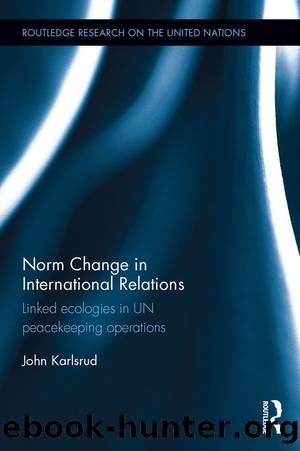Norm Change in International Relations: Linked Ecologies in UN Peacekeeping Operations by John Karlsrud

Author:John Karlsrud [Karlsrud, John]
Language: eng
Format: epub
Tags: Political Science, General, International Relations, Treaties, NGOs (Non-Governmental Organizations)
ISBN: 9781317374800
Google: JKc0CwAAQBAJ
Publisher: Routledge
Published: 2015-12-14T04:31:31+00:00
Simon Adams, Director of the Global Centre for the R2P, asserts that âdiscussions now are not whether R2P is a good norm, but what Pillar 3 on âcoercive meansâ meansâ (interview with Simon Adams, Director of the Global Centre for the R2P, September 26, 2011, New York). Contestation over the meaning of R2P has thus been an ongoing feature of the norm, long after its adoption.
This chapter examines the norm change process concerning R2P, from when the term was first coined until today (see also Karlsrud 2013). It does so by asking who the main actors have been in the drive to establish the norm and what consequences this can have for understanding and theorizing norm change in international organizations. I employ the conceptual framework describing R2P developed by Bellamy (2009), who distinguishes between describing R2P as a concept, a principle, or a norm. He argues that for the period prior to the adoption of R2P by UN member states in 2005, R2P should be considered as a concept, whereas since its adoption it should be recognized as a principle, since the member states have âagreed on its content and have pledged to act in accordance with itâ (ibid., 7). Discussing R2P as a norm is a separate question, he holds; it involves inquiring into how the norm is translated from concept to principle and how the norm has evolved, using theories of norm change. This chapter seeks to elucidate the norm change process concerning R2P using a blend of constructivist theories, the sociology of professions, and practice theory.
I begin with a short narrative of the development of R2P, tracing its historical antecedents until the inclusion of R2P in UN Security Council Resolution 1970 on Libya in 2011 (UNSC 2011a) and the subsequent discussion on R2P. In the second section, applying the theory framework, I show how the sociology of professions can enrich constructivist theories of norm change in international organizations. In this section I analyze the process in greater detail, highlighting what actors were involved and the roles they played. The next section takes one step back and examines the process of R2P and the roles of the various actors and their interaction during the process. That section draws on the sociology of professions to augment our understanding of how R2P has been advanced as a norm through informal alliances. At the end of the section I emphasize how the interaction with other ecologies has been instrumental in advancing the R2P norm and the role of policy alliances. In concluding, I note the need for further exploration of the potentially fruitful application of the theory framework and the need for a fundamental rethink concerning agency in norm change processes of international organizations.
Download
This site does not store any files on its server. We only index and link to content provided by other sites. Please contact the content providers to delete copyright contents if any and email us, we'll remove relevant links or contents immediately.
What's Done in Darkness by Kayla Perrin(25499)
Shot Through the Heart: DI Grace Fisher 2 by Isabelle Grey(18218)
Shot Through the Heart by Mercy Celeste(18159)
The Fifty Shades Trilogy & Grey by E L James(17773)
The 3rd Cycle of the Betrayed Series Collection: Extremely Controversial Historical Thrillers (Betrayed Series Boxed set) by McCray Carolyn(13188)
The Subtle Art of Not Giving a F*ck by Mark Manson(12903)
Scorched Earth by Nick Kyme(11831)
Stepbrother Stories 2 - 21 Taboo Story Collection (Brother Sister Stepbrother Stepsister Taboo Pseudo Incest Family Virgin Creampie Pregnant Forced Pregnancy Breeding) by Roxi Harding(11036)
Drei Generationen auf dem Jakobsweg by Stein Pia(10216)
Suna by Ziefle Pia(10185)
Scythe by Neal Shusterman(9258)
International Relations from the Global South; Worlds of Difference; First Edition by Arlene B. Tickner & Karen Smith(8607)
Successful Proposal Strategies for Small Businesses: Using Knowledge Management ot Win Govenment, Private Sector, and International Contracts 3rd Edition by Robert Frey(8416)
This is Going to Hurt by Adam Kay(7693)
Dirty Filthy Fix: A Fixed Trilogy Novella by Laurelin Paige(6450)
He Loves Me...KNOT by RC Boldt(5804)
How to Make Love to a Negro Without Getting Tired by Dany LaFerrière(5376)
Interdimensional Brothel by F4U(5302)
Thankful For Her by Alexa Riley(5158)
